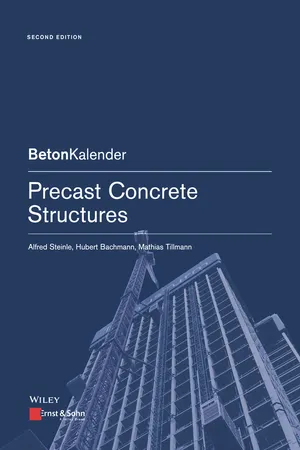
eBook - ePub
Precast Concrete Structures
This is a test
- English
- ePUB (mobile friendly)
- Available on iOS & Android
eBook - ePub
Precast Concrete Structures
Book details
Book preview
Table of contents
Citations
About This Book
Building with precast concrete elements is one of the most innovative forms of construction. This book serves as an introduction to this topic, including examples, and thus supplies all the information necessary for conceptual and detailed design.
Frequently asked questions
At the moment all of our mobile-responsive ePub books are available to download via the app. Most of our PDFs are also available to download and we're working on making the final remaining ones downloadable now. Learn more here.
Both plans give you full access to the library and all of Perlego’s features. The only differences are the price and subscription period: With the annual plan you’ll save around 30% compared to 12 months on the monthly plan.
We are an online textbook subscription service, where you can get access to an entire online library for less than the price of a single book per month. With over 1 million books across 1000+ topics, we’ve got you covered! Learn more here.
Look out for the read-aloud symbol on your next book to see if you can listen to it. The read-aloud tool reads text aloud for you, highlighting the text as it is being read. You can pause it, speed it up and slow it down. Learn more here.
Yes, you can access Precast Concrete Structures by Alfred Steinle,Hubert Bachmann,Mathias Tillmann, Philip Thrift in PDF and/or ePUB format, as well as other popular books in Tecnologia e ingegneria & Ingegneria civile. We have over one million books available in our catalogue for you to explore.
Information
1
Introduction
This book first appeared as an article written by Alfred Steinle and Volker Hahn for the 1988 edition of the Beton‐Kalender. It was reprinted in Beton‐Kalender 1995 and then published as a book in the Bauingenieur‐Praxis series in 1998. Hubert Bachmann, Alfred Steinle and Volker Hahn updated the information for publication in Beton‐Kalender 2009 and this appeared as a new edition of the book in the Bauingenieur‐Praxis series in 2010. Alfred Steinle, Hubert Bachmann, and Mathias Tillmann reconceived and completely revised the content for Beton‐Kalender 2016, and it is that version that has again been published as a separate book, the third German edition, as part of the Bauingenieur‐Praxis BiP series.
The first chapter looks at general aspects of precast concrete construction, its history and the status of European standardisation. The economic use of precast concrete elements is only possible when the design is carried out to suit the production and erection of such elements. Therefore, the second chapter deals with the design of precast concrete structures. Besides outlining the boundary conditions that must be observed when designing for precast concrete, the authors present a number of typical precast concrete designs.
Special attention must be paid to the connections between precast concrete elements, because these are the weak points – for horizontal loads in particular. The stability of precast concrete structures is therefore described in detail in Chapter 3. In particular, owing to the need to check critical details, proper yet simplified engineering assessments are to be preferred to computer calculations when considering stability. Chapters 4 and 5 deal with the various components of precast concrete production and the connections between those components. Specific design issues are examined in detail in Chapter 6.
Façades are becoming an increasingly important application for precast concrete elements. Chapter 7 is therefore dedicated to this topic. And it is façades in particular that are making use of new types of concrete and reinforcement. The final chapter looks at the actual manufacture of precast concrete elements so that the reader gains a full understanding of this form of construction taking into account the needs of production.
New types of concrete, new types of reinforcement, new methods of production – precast concrete construction is the chief proving ground for new developments and applications. Precast concrete therefore represent one of the most innovative forms of construction, a fact that is reflected in its growing popularity.
Although this book focuses on precast concrete from the point of view of the building industry and the authors concentrate mainly on buildings in general, it should not go unmentioned that precast concrete construction has been able to win considerable market shares in many other construction sectors through the development of economic yet bespoke solutions. Examples of these are bridges, tunnel linings, pipes, pipe bridges, towers, masts, piles, detached homes, prefabricated basements, retaining walls, room modules, prefabricated garages, noise barriers, railway sleepers, guided bus tracks, agricultural buildings, ballastless tracks, cooling tower trickle fill structures, etc. The reader is referred to the specialist literature dealing with these specialist areas. This book also only describes structural or arc...
Table of contents
- Cover
- Table of Contents
- Foreword
- Preface to the Third German Edition
- About the Authors
- 1 Introduction
- 1 General
- 2 Design of Precast Concrete Structures
- 3 Stability of Precast Concrete Structures
- 4 Precast Concrete Elements
- 5 Connections for Precast Concrete Construction
- 6 Individual Design Issues
- 7 Precast Concrete Façades
- 8 Production
- Index
- End User License Agreement